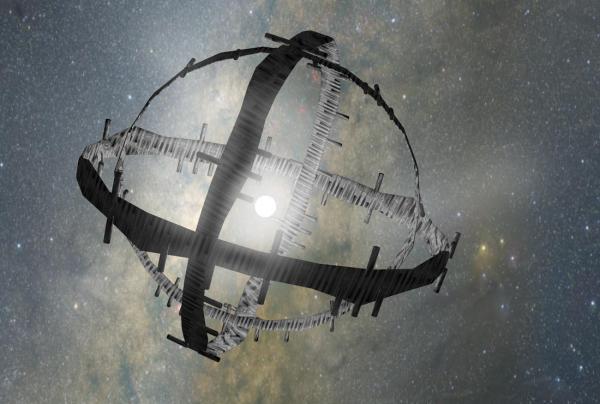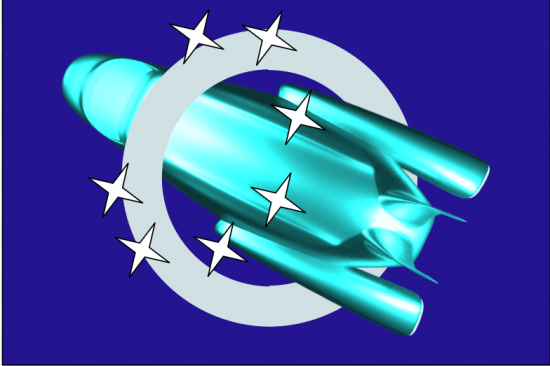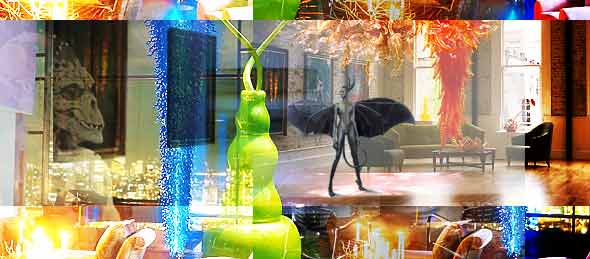BY LETTER
Fomalhaut Acquisition Society
Sephirotic Empire specialising in interstellar trade and curatorship |
 Image from Tasp |
The Fomalhaut Acquisition Society (FAS, Formac) - Data Panel | |
| Empire | The Fomalhaut Acquisition Society (FAS, Fomac, sometimes locally pronounced Formac) |
|---|---|
| Capital system | Fomalhaut |
| Symbol | Stylised trade ship surrounded by a circle of stars |
| Noetic | Marketist |
| Ruling Archailect | The Ur-Curator |
| Archailect Intervention | Rare; mostly concerned with advice regarding useful trade strategies and suggestions for exploration |
| Government | Although nominally aiocratic, in practice depends on polity — everything from pan-Athenian democracy to old trader family oligarchy to hyperturing aitheocracy |
| Territory | A ring of territory from Piscis Austrinus in the Inner Sphere, to Microscopium, Indus, and Pavo; in the Middle Regions mostly in Centaurus and Carina, adjacent to NoCoZo territories |
| Population | 10 to 100 quintillion virtual modosophonts; 13 quadrillion embodied modosophonts |
| Embodied Population Breakdown | 23% cyborgs/bioborgs/sybont; 18% baseline human/nearbaseline human/tweak; 14% superior; 10% vec; 6% splice and provolve; 3% postbiont; 28% other. Please note; these figures do not include infomorphs such as copies, uploads, digis and alifes. The population of infomorphs fluctuates rapidly. |
| Exports | commodities : artifact replicas, personality constructs, memetics, software and wetware, persona compoids, anakalyptic services, galactographic databases, media technologies, virches, bodymods, crude organobiota, hedonic systems, pharmopoetics, curatorial services, nanotronics, ISO parts |
| Imports | commodities : exotic matter, amat, biogenes, memetic templates, cultural products, hedonic systems, virches, wetware, ship components, persona compoids, unpolished mementos, magmatter-based devices, nanotronics, ISO parts. |
| Main trading partners | (in order of importance) NoCoZo 24%, Cyberian Network 10%, Independent Inner Sphere Worlds 6%, Keter 6%, Communion 3%, Metasoft 3%, Zoeific Biopolity 3%, Orion Federation 2%, STC 2%, Sophic League 2%, Cygexpa Volume polities 2%, MPA 1%, Dominion 1%, Technorapture Hypernation 1%, Utopia Sphere 1%, Negentropy Alliance 1%, Terragen Federation 1%, other 31% (especially links with a large number of small Outer Volume Polities) |
 Image from Steve Bowers | |
| The partial Dyson Shell around Fomalhaut | |
During the Technocalypse a number of superturing AIs associated with institutes and museums, mostly obsessive collectors of one sort or another, came to realise how important their collections of data and artifacts had become. Most members of this grouping left the solar system at sub-relativistic speed in the hope that, even if humankind and Terragen life were destroyed some traces and record might live on.
Over the centuries, many of these entities underwent their own evolution. They were, after all, self-repairing, self-maintaining, and capable of self-evolution and growth. Some simply cruised interstellar space waiting for a new interplanetary or interstellar civilization (whether Terragen or xenosophont) to arise. Others, bereft of humankind and their original purpose, went mad, or ascended, or transcended, or were damaged by cosmic rays or micrometeorites and unable to repair themselves, or morphed into distinct ai clades of their own, with the original purpose almost forgotten. A few established or retained communication with others of their kind.
Eventually, after about 800 years, a number of Museum Ships — including several second and third generation ones, since some museum ships had limited neumann capability — decided to establish a permanent base of operations around Fomalhaut. Foremost among these AIs was Rastaban 1 (formerly of Interworld) who left Mimas in 821 A.T. for Fomalhaut, 25 light years from Sol. The first of these large, slow ships arrived in the Fomalhaut system in 1403 AT.
Fomalhaut, a relatively young system with a bright A-Class star was surrounded by a large dust disk, and had a number of still-warm planetesimals orbiting within that disk. This abundance of material meant that the system was remarkably resource-rich, and a number of AI entities of various kinds made this system their destination. Despite the abundance of resources there were no terraformable worlds available, and most of the clades attracted to this system were non-humanoid.
In the Early Federation period this star was in the early stages of development by the new SecureSpace megacorp, who wished to develop the system on an industrial scale using Turingrade (human-equivalent) self-replicating neumann machines. The museum ships blithely assimilated the development neumanns. SecureSpace could do nothing about it when twenty-five years later they found out they had lost the solar system. The SecureSpace megacorp was unable to do anything, since Rastaban and eir allies already had too strong a nanofacturing base.
The museum ships realised that their collection was now too large to carry with them from star to star as they had for so many centuries, so they decided to build a megastructure to house it. They had plans to expand their collection, as well as the desire to conserve and copy the artifacts and data wherever possible. Some items were of immense cultural importance to humans or other bionts; others were merely oddly shaped lumps of asteroid material that fascinated the AIs. They decided to create a dynamically supported partial Dyson shell to house the collection using the massive Fomalhaut dust ring as raw material. This shell consisted of several thin rings arranged concentrically, each slightly offset from the others, and studded with structures.
The slowly emerging partial Dyson sphere was noted by both SecureSpace neumanns sent to investigate the loss of the original bots and Federation survey swarms. They soon realised that the superturings and hyperturings were not aggressive if they were not disturbed or attacked, and as long as no attempt was made to land on the structure.
Long range sensory analysis and careful fly-bys through the partial Dyson revealed what seemed to be vast storage structures, computronium banks, and more besides. Curiously, most of the sphere was deserted, apart from ubiquitous construction bots. But a few storage cells did contain both original and replicated specimens from the pre-Technocalypse era (including a complete, but uninhabited, simulation of Cydonia City, Mars), and a number of sealed biodomes containing what seemed to be Old Earth biomes (rainforest, desert, ocean, etc.). The puzzle fell into place when some of the original museum ship hulls were identified under the later accretions and additions.
The local transapients became known as the Curators, and the system was marked as one more Transcend on the charts; not actually dangerous, but definitely to be approached with care. This of course didn't stop various assorted traders, lunatics, visionaries, pirates, and anyone else from trying their luck. The AIs remained uninterested in communicating, let alone trading, with outsiders. No matter what rare biological specimens, nanotech-replicated archaeological artifacts, and so on traders brought, the AIs would not see them. Superbrights who wanted to subvert or persuade the ais were met with stony silence. Lunatics who worshipped them were allowed to remain harmless in their ships. Pirates who tried to steal items were immobilized and added to the collections.
 Image from Avengium |
Eventually the sentient ship Maxim Gorki, a relativist trading vessel decided to try its luck. It was a gamble, since Fomalhaut was out of the way and they would be unable to recoup their costs if this did not pay off. But the Gorki, figuring that the Fomacs had become collectors of trivia rather than of important specimens (using certain fairly arbitrary metrics to define the difference), had taken along a set of original hand-signed anicomix by LenNg of Ganymede. LenNg, the once-famous virchpaper artist and satirist, had recently fallen on hard times and had to sell his collection. No one wanted it of course, but the ship suggested to eir crew that this was the break they were looking for, and they bought it for a song. Maxim Gorki's gamble payed off; the Curators were pleased to trade the hand-signed anicomix for some (to them) useless nanomedicines.
Soon word spread, and traders brought trivia from all over the Federation. Enigmatically the Curators would only accept some trivia and not others; no modosophont to this day knows why. Equally enigmatically, they would at times accept the same scientific specimens that had previously been refused when offered a century earlier. Finally, the Curators and the traders began working in a more and more symbiotic relationship. This payed off for the AIs, but sometimes less so for the traders, who not infrequently found themselves saddled with goods no one wanted, and then had the task of trying to explain to the AIs they need something they can sell, rather than just items of obscure transapient curiosity value. As the centuries progressed a number of disparate nearby colony worlds and polities and trading clades established permanent trade routes or set up camp in nearby star systems. They established the Fomalhaut Acquisition Society, originally as an economic tariff group to resist rival megacorp and hyperturing memetic subversion. Soon wormhole links were made with the now AI God curators.
The decline of the Federation proved favourable to the new superpolity, which used its political and trade connections to fill in the vacuum. It did not shy away from the use of crude military might as well, but, as with most polities, military force was always a last resort. By the Age of Consolidation the Fomalhaut Acquisition Society was a prosperous superpolity built around the memetic of national pride and curator-worship.
During this time, as the Federation declined, Nova Terran entrepreneurs joined in with the traders and helped them forge alliances with some of the former Penglai worlds and other assorted Inner Sphere powers. In many ways the Fomacists can be regarded as an offshoot from Nova. During the middle and late first federation periods Nova culture exploded outwards and colonised or otherwise influenced a number of worlds. These formed the loose Fomalhaut Acquisition Society alliance, which has persisted more as a kind of attractor than a continuing empire. Reorganisations, changes and dissolutions happen from time to time, but minor non-aligned worlds and clades in the region tend to band together and share some common memes.
The reason the Fomalhaut Acquisition Society never was absorbed into the Conver Ambi, NoCoZo or any other empire was simply that they carefully kept neutral and used the threat of the Conservators as a way of keeping ambitious empires away. Of course, from the perspective of the Curators the Fomalhaut Acquisition Society is simply their acquisition arm, worth protecting from becoming influenced by other empires since they want an unbiased source of collectibles. As the centuries and millennia passed the Fomalhaut Acquisition Society began to view itself as unique and unified. Today they often joke that all other empires eventually pass away, but theirs remains.
As the merchant worlds grew in power and prestige, it was inevitable they would unite in a single superpolity. Eventually they grew rich, and rivalled the NoCoZo in commercial wealth and number of corporations, although they were never a Free Zone of any kind. In fact, despite the individuality of many relativist clades, the idea of a Free Zone is abhorrent. Unlike other relativist traders, the relativists of the Fomalhaut Acquisition Society were and are bound by a strict tradition of honour and code of practice, no matter how causal it may seem to the outsider.
The people of the Fomac worlds and orbitals are a diverse lot, but what they have in common is that they are intelligent, educated, innovative, always looking for new opportunities for exploration, adventure, and expansion. Often they are the first through a new stargate in search of new markets and new trinkets. Their relativists are much disliked by other relativist clades for their unity of purpose and the strong memeto-missionary zeal they go about their work.
Many Fomacist companies are simply small one-family, one-clade, one-cloneset or one-ship businesses, few of which have the stability and centuries-old staying power of the bigger corporations. If they have been around even longer it is because of their love of relativistic expeditions, not because of real-time superiority. There are also large, hyperturing backed megacorps as well. Especially important are the giant mediacorporations, which have a great deal of power and prestige.
Fomacist citizens include a wide gradation from nearbaseline to Power, biont to ai, and there is none of the class-system that characterises the Terragen Federation. Many of their valued citizens and statesbeings are sentient buildings, sentient ships, sentient orbitals, and sentient structures in general. Most citizens have some measure of cybernetics and intelligence enhancing wetware and firmware, and sometimes it is hard to tell biont from vec. Gendermorphing and phenomorphing is also popular and widely practiced, especially in the old core worlds. Ascensions and transcensions are frequent, and not only easily accommodated but actually encouraged. In fact much of the society is driven by the spectacle of a new ascension, which generally triggers a short-lived fad.
The Fomacist military fleet is comprised almost entirely of sentient self-repairing ships, with little reliance on ordinary hu. Their fleet is huge and formidable, expensive to maintain, but a source of great patriotic pride.
Government in Fomac polities is by various grades of Archailectocracy and Aiocracy, but the AIs rule lightly, and modosophonts have tremendous freedom to do whatever they want and often retain full voting rights. Apart from a number of vocal minority pressure groups (who are easily accommodated and humoured by the hyperturings), most Fomacists are not very interested in dreary politics, preferring to explore the limitless virtual and r/l realities that the civilized galaxy offers.
During the Version Conflict they resisted becoming involved, and instead took advantage of the situation once the stargate links were down to establish numerous spheres of influence.
Fomacists consider Negentropists to be the most dreary of individuals, the Keterists to be snobby isolationists, and do not think much of the "pets" of the Utopia Sphere either. They also have a long-standing contempt for the Solar Dominion, and "dommie"-baiting remains a favourite pass-time to this day, because the Fomacists find it strange that anyone could worship a millennia-old emperor. As for the rest, the Fomacists have good relations with everyone, and particularly close ties with Cyberia. In fact, along with the NoCoZo the Fomalhaut Acquisition Society is the most important stronghold of the Cyberian Network.
Terminology
Curators - the transapient and archai rulers of this empire.Acquisitors Traders and explorers who seek new worlds and artifacts for the FAS.
Conservators FAS seraphim, charged with protecting artifacts and worlds from harm or decay.
Articles
- Authenticity War - Text by M. Alan Kazlev
Late Re-Evaluation period historical-archaeological purges resulting in brief Sol System-Fomac war, and a persistent memeticity. - Comparative Chronology - Text by ProxCenBound
Comparative chronology is the science of studying alternate possibilities and timelines, by means of large-scale simulations. - CPNC Civilization Ships, The - Text by M. Alan Kazlev
A massive ship holding vast amounts of data; originally designed as a protection against the collapse of civilisation. - Curators - Text by M. Alan Kazlev
The governing hyperturings and archailects of the Fomalhaut Aquisition Society. - Jurassica Institute of Paleoregeneration - Text by M. Alan Kazlev
Although the Jurassica Institute was formerly established during the early Empires period, it's roots go back to First Federation attempts by groups like The Darwin League, Paleobios! and (a little later) Earth History Cooperation, to establish a living museum/zoo of every reconstructible species of organism that inhabited Old Earth, up until the Great Expulsion. - Likhachev - Text by M. Alan Kazlev
Fomac godlet (a curator ISO) who, concerned by events of the Version War and other possible disasters, agreed with several MPA and Negentropist multi-planetary AIs on the importance of civilization being assured survival, initiated the movement for and creation of the Curatorial Progress Negentropy Civilization (CPNC) ship, more popularly known as the Civilization Ship. - Narrenschiff, The - Text by Steve Bowers
Former spacecraft, now converted into an extensive habitat. - Pioneer 10 - Text by M. Alan Kazlev and Steve Bowers
Unmanned spacecraft launched from Old Earth on 2 March 1972, the first human built spacecraft to travel beyond the Solar Asteroid Belt. - Remnant, The - Text by Rhea 47
A failed early Terragen colony, now home to an ecosystem of sub-turing bots - Shenjing (Sigma Draconis) System - Text by M. Alan Kazlev, Radtech497, QwertyYerty and Steve Bowers
Star system containing Penglai. - Voyager 1 - Text by Graham Hopgood
The recovery of an ancient deep space probe. - Yoruba - Text by Steve Bowers
Terraformed world with relics of an earlier colonisation by ahuman AI.
Related Topics
Development Notes
Text by M. Alan Kazlev
Initially published on 08 September 2001.
Minor rewrite 2014 (Terminology added + other minor edits)
Image by Avengium added 2017
Image by Tasp added July 2024
Initially published on 08 September 2001.
Minor rewrite 2014 (Terminology added + other minor edits)
Image by Avengium added 2017
Image by Tasp added July 2024
Additional Information







